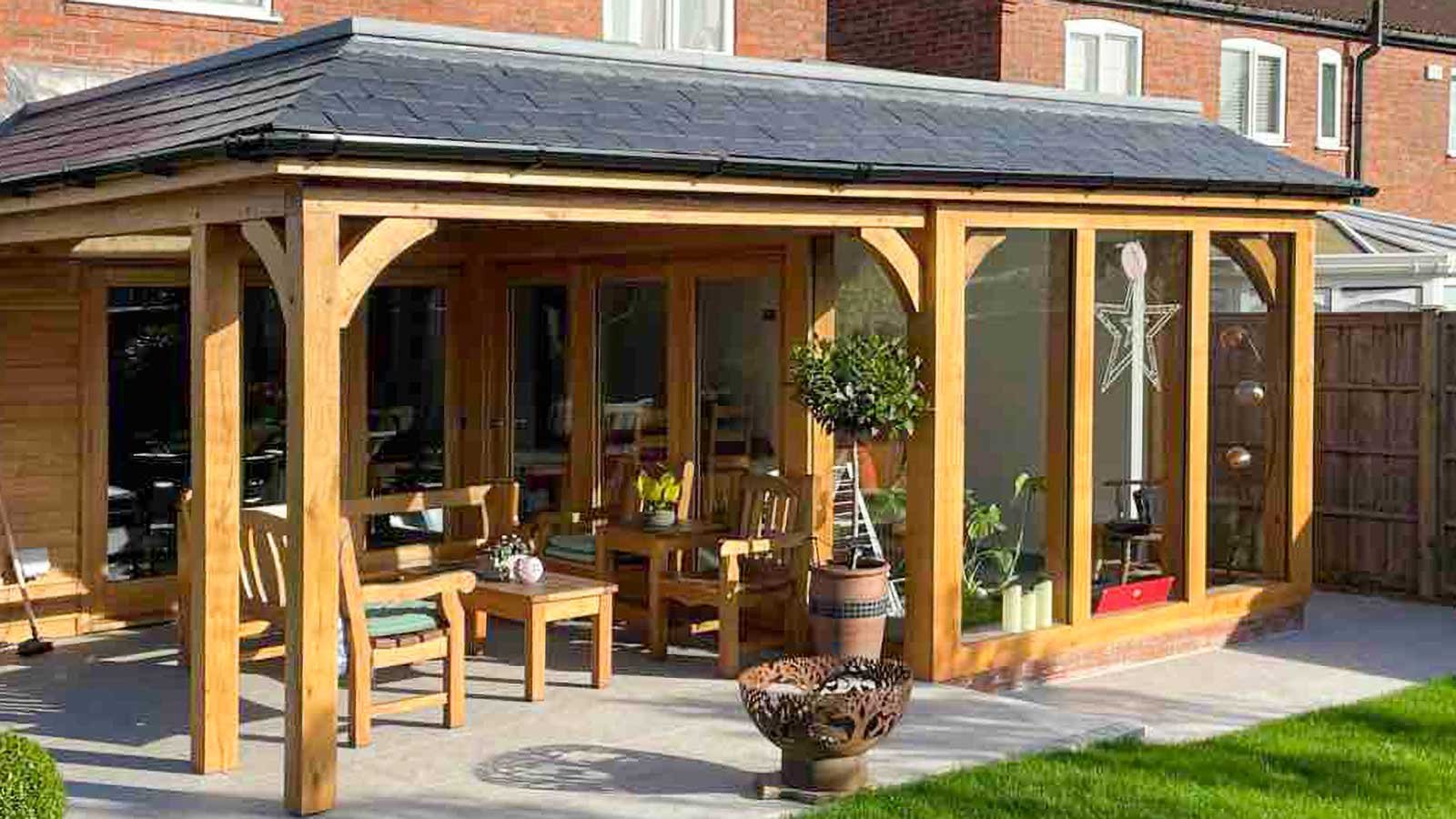
oakbydesign
01423 593 794


Hannah and Charlie Stevens bought their present home a couple of years ago in the September. Built in the late 1980’s, it is a lovely family home, set within a spacious garden in a popular village on the outskirts of York.
The home came with a white UPVC conservatory, very typical of the period of the home. Over the years it had started to let in water, and as is usual with these types of conservatories, they tend to be cold in winter, and hot in the summer. This can be seen on the photo at the bottom of this article.
Replacing theirs with a contemporary oak sunroom, and making other changes to the property, was on their ‘To Do’ list after moving in.
Friends recommended Oak By Design, and after checking out the website, and really liking our work, they contacted us a couple of months after moving in to their home.
Jamie initially spoke to the couple and then arranged a visit to their home the following week to talk through their plans.
They wanted to remove their existing UPVC conservatory, and replace this with oak sunroom . They wanted oak bi-fold doors so that they could open the room up to the garden in the good weather.
They also planned on knocking through between their existing kitchen and dining room, (which both looked out onto the garden) to create one large space, which in turn would open onto the new oak conservatory, thereby creating a large L shaped open plan room.
This wasn’t to be just an oak sunroom though. They also planned an open, outdoor area alongside the sunroom, with the advantage of the hipped roof continuing over, forming the perfect “all weather” sitting out area.
In total the length of both areas would be over 6.5 metres, running across the back of the house. The depth of the new oak sunroom is approx. 4 metres.
After a few design meetings, the final plans were drawn up for the oak sunroom and sitting area. Planning Permission was approved and manufacturing was planned into the production calendar.
As well as bi-fold doors from the oak sunroom into the outdoor seating area, another set of bifold doors were to be installed. These would lead from the new room directly outside into the outdoor sitting area.
With both sets of doors open this would create a fabulous, large open space, perfect for indoor/outdoor living and hosting large numbers of people!
Oak posts, and curved oak brackets would support the roof, and a large roof light would be installed into each of the 2 halves of the new area.
Curved brackets would also be installed internally on the oak sunroom, creating a cohesive look throughout.
All the oak would be finished with Osmo Polyx UV oil in 420, a clear satin finish.
Work began on the home renovation and once the oak framework was ready, our installation team set to, working alongside the builders and other trades.
The build was complete during the summer and provided the perfect space for enjoying the warm evenings outside. The roof lanterns not only provide more light in both the oak sunroom and outside area, but provide a perfect frame of the night sky!
Flush, chrome light fittings are installed on the underside of the hipped roof, which add a twinkling effect on an evening.
The couple chose to finish the area around the bi-fold doors to the outside area, with oak boards. This really has created the perfect outdoor seating area. Protected on 2 sides by the house, and a full roof to protect from the weather – the family should be able to enjoy this space all year round.
Oak conservatories are a remarkable addition to any home. The combination of aesthetic appeal and functionality makes these structures an ideal choice for those looking to enhance their living space. This article aims to explore the various aspects that make oak conservatories so appealing.
One notable feature of oak conservatories is their timeless beauty. The natural warmth and elegance of oak create a welcoming atmosphere, ensuring that your conservatory becomes the focal point of your home. The intricate craftsmanship involved in constructing an oak conservatory further enhances its charm, making it a true work of art.
In addition to their visual appeal, oak conservatories offer practical benefits as well. The use of high-quality timber ensures excellent insulation, making them suitable for year-round use regardless of the weather conditions outside. Furthermore, the durability and strength of oak ensure that your conservatory will stand the test of time, requiring minimal maintenance over the years.
Another advantage provided by oak conservatories is their versatility. Whether you intend to use it as a dining area, a relaxation space, or even a home office, an oak conservatory can be tailored to meet your specific needs and preferences.
To conclude, choosing an oak conservatory is not only a wise investment but also an opportunity to add character and functionality to your home. Its timeless beauty combined with practical advantages make it an appealing choice for homeowners seeking to create a distinctive living space that stands out from the ordinary.
The utilisation of timber in construction is a time-honoured tradition, with oak being a popular choice due to its durability and aesthetic appeal. However, there are distinct differences between green oak and air-dried oak that warrant careful consideration when selecting the appropriate material for building projects.
Green oak is derived from recently felled trees, retaining a substantial moisture content ranging from 60-80%. As this timber undergoes seasoning, which refers to the gradual drying out process, its moisture content diminishes. The visual imagery of water gradually evaporating from the wood aptly depicts this transformation.
In contrast to green oak, air-dried oak is cut into desired sizes and exposed to natural elements for an extended period. This exposure allows for air circulation between the timbers, facilitating the reduction in moisture content over time. The pace at which air-dried oak dries out is captured by the evocative phrase "25mm per year," highlighting the slow but steady progress of drying.
Air-dried oak possesses lower moisture content compared to green oak due to its lengthy seasoning period, typically ranging from three to ten years depending on thickness. This reduced moisture content enhances stability and minimizes movements or shrinkage associated with timber use in construction projects.
Understanding the distinctions between green oak and air-dried oak grants building experts invaluable knowledge when making material selections. By considering factors such as moisture content and stability, professionals can ensure optimal outcomes in their construction endeavours without compromising quality or longevity.
Telephone: 01423 593 794
Locksley Park
Blind Lane
Tockwith
YORK YO26 7QJ
Opening Times:
Mon to Fri - 9.00am to 5.00pm
Bank Holidays - Closed
Christmas 2025- TBC
Oak By Design is the trading name of:
Oak By Design Ltd.
Reg Number: 04384416
VAT Number: 664 8012 33